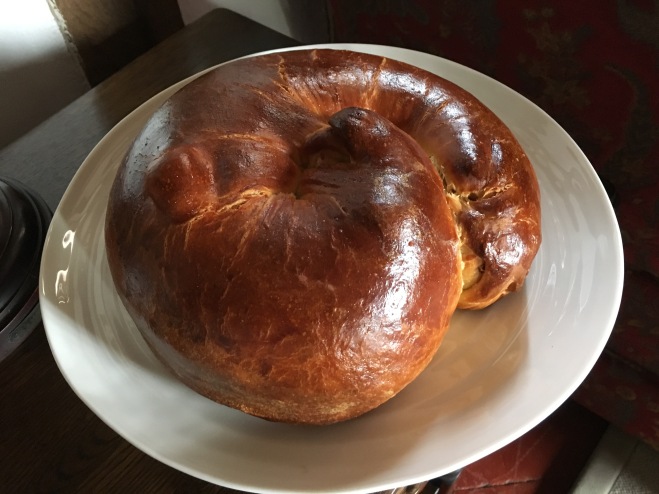My Easter Baking has begun and with so much choice from around the world (see my last post here) I was struggling to make a decision about what to do first. My first thoughts were a Simnel Cake, but I realised I needed to take one to my mother over Easter. Also we are making a special trip to see my godmother in Manchester and I know she would like one as well. The Simnel Cake will therefore be making an appearance later this week. That left me in a quandary. Amazon have just told me that the Bundt and Lamb shaped cake tins will not be here until mid April so Babka and Lammkuchen are out, leaving me looking at the breads. The Gubana (or the Dolce & Gubana as one of our Facebook friends wagged) just jumped out of the page. Also the hubby speaks Italian and has a love for all things Italian, so I thought it was time to leave Germany and Austria for sunnier climes.
The Gubana is an Easter tradition from the province of Friuli Venezia Giulia, the alpine part of Italy neighbouring Austria and Slovenia. The combination of nuts, spices, alcohol, chocolate and dried fruit rolled in Brioche is absolutely delicious. Its heritage bears more relationship to Friuli’s close connection to the Austro Hungarian empire rather than Italian baking. Indeed its name probably comes from the Slavic word for fold, “guba”. The Balkans has a very similar but more complex confection called the Potica which I do intend to try some time, and there are many versions of this type of rolled brioche in Austria and Germany . The truly unique thing about the Gubana is the shape which you will find nowhere else.
The cake has very old origins and is a particular speciality of the very picturesque city of Cividale del Friuli. It was served, along with 72 other dishes, to Pope Gregory XII during the Council he held in the city in 1409 where very briefly Cividale became the centre of the political wranglings over the Papal schism between Avignon and Rome.
It is served at both Christmas and Easter and has all those elements of old celebration cakes – yeast for a rise (Baking Powder was only commercialised for baking use in the 1890’s by Dr Oetker – he of the little Päckchen I find so trying in German recipes), and spices, nuts and dried fruit – ingredients that were incredibly luxurious in the 15th Century.
The variations in recipes are not great. Some use Grappa or Plum Schnapps (Slivovitz), others use Marsala, others both. Candied peel of some sort is in or out, and some are finished with a shiny egg wash and others covered in a dusting of sugar. For the filling binder, some use sponge fingers, others amaretti and others brioche bread crumbs. Apart from that the recipes the husband and I have found are pretty consistent. Italy despite all appearances is a very very conservative place.

The method is not complex if you know bread making, but it really can’t be rushed. The dough in this recipe is enriched with eggs , sugar and butter and that initially inhibits the yeast from getting going. It also has a huge weight in filling to lift, so you really need to get the yeast as active as possible at the start, using the sponge method. Do not jump the “sponge” stage as I did or else you are in for a long wait between proving stages. This means you need to start the night before you want to bake, something I usually do just before bed time.
The result is a denser bread than a panettone with lovely subtle flavours from the citrus and alcohol. Perfect with a cup of tea or a cup coffee after a hard day in the garden, as the husband and I discovered a few hours ago when we broke our golden baking waist line preservation rule and ate 2 slices.

The Recipe
The Ingredients

For the Brioche
- 450g plain flour
- 110g caster sugar
- 7g (sachet) dried yeast
- pinch of salt
- 1 whole egg (room temperature)
- 1 egg yolk (room temperature) (set the egg white aside)
- 1 tsp vanilla extract
- Zest of 1 Orange / 1/2 tsp orange extract
- 100g butter (melted)
- 100ml milk (lukewarm)
- 25ml slivovitz/grappa/schnapps (if unavailable make up with milk)
- 1 egg for brushing over the dough
Filling
- 125ml marsala
- 170g raisins
- 100g hazelnuts (no skins – online seems to be the few places to get this)
- 100g walnuts
- 50g pine nuts
- 80g savoiardi (sponge finger biscuits) broken up (or brioche breadcrumbs or amaretti)
- 40g mixed peel or candied orange peel
- 2 tbsp cocoa or 20g dark chocolate finely chopped
- 1 tsp mixed spice
- 1 tsp cinnamon
- Zest of 1 lemon
- 1 tbsp honey
The Method
The Stages
- Grease a 20cm spring form tin
- Make the “sponge” the night before
- Make the brioche dough and prove for at least 1 hour
- Soak the raisins
- Make the filling
- Assemble the Gubana and prove again for at least 1 hour
- Bake for 1 hour
- Make cappuccino and serve
The sponge stage
Making a “sponge” in bread making is one of the techniques bread makers use for increasing flavour of the bread and the activity of the yeast. I didn’t do this and paid the price in much longer (3-4 hour) proving times at each stage.
The night before you are ready to bake
- combine half the flour, all the milk, and yeast and mix together
- cover the bowl with cling film and set aside somewhere warm
The next day you will have a small spongy monster in your bowl – hence why this is called a sponge.
Making the dough
Ideally this is done using a stand mixer with dough hook. Otherwise get ready for 10 minutes of shoulder exercise hand kneading the mix
- mix the flour, salt, orange zest, together and make a well
- melt the butter
- whisk the eggs lightly
- combine the eggs and butter with the luke warm milk, vanilla extract, and grappa
- pour into the well of flour and mix
- add the sponge mix from the night before and mix thoroughly
- knead using the dough hook until the mixture comes away form the sides of the bowl
- it is ready when it has a silky smooth texture and it can be stretched to a thin film without breaking
- form into a neat ball, place in a bowl, cover with cling film and set aside somewhere warm to prove
- wait for the mixture to double in size – this cannot be hurried. Sometimes it takes an hour, sometimes longer
Making the filling
- combine the raisins and marsala in a saucepan and heat until just about to simmer, then cover and set aside to cool
- finely chop the nuts (I use the pulse mode on a food processor but be really careful not to end up with ground nuts – you want small nut pieces)
- finely chop the biscuits/brioche/ameretti to the same consistency of the nuts
- combine all the remaining ingredients along with the raisins, marsala, nuts and biscuits – it will be the consistency of a very thick paste
Assemble the cake
- grease a 20cm spring form tin
- once the dough has doubled in size, take out of bowl and gently knead a couple of times and form a small ball
- cover and leave to sit for 10 minutes (this allows the dough to relax making the next stage a lot easier – see below)
- lightly flour your work surface
- roll out the dough to a rectangle about 50cm x 30cm, with the long edge facing you
- NOTE: Bread dough tightens up when kneaded making it really hard to roll out if you do it straight after kneading because it keeps on springing back to its original size (which can be really frustrating). If you wait for 10 minutes the tightening up effect disappears which means you can roll it out much more easily (my scientific friend, Paul will no doubt be ablate explain the science behind this phenomenon)
- spread the mixture leaving a 2cm edge all around
- secure the far long edge to the work surface by pressing it down
- roll the dough up as tightly as possible from the long edge
- seal the ends and tuck them underneath your roll (not like in the photo)
- curl the dough into your tin in the shape of snail shell
- put the tin into a plastic bag (I use small bin bags) to stop the cake drying out during the prove
- wait for the cake to rise by about 1/3rd- again this will take at least an hour – the yeast has just had a second sugar shock chased with a shot of alcohol
Bake the cake
The bake takes one hour on a low temperature
- preheat the oven to 180c / 160C fan
- lightly whisk one egg and brush over the surface of the cake keeping some for later (there is always too much)
- bake in the oven for 20 minutes
- reduce the temperate to 160c / 140c fan
- bake for another 20 minutes
- briefly take the cake out of the oven, take the side of the spring form off and brush the sides with the egg
- bake of a final 20 minutes
- remove the cake from the spring form base and cool on a wire rack
If you want to do the sugar topped variety brush the cake in the egg white reserved from the dough and sprinkle with caster sugar. Then bake in the same way as above. If you want to get the sides covered in sugar as well then take the cake out the tin after 40 minutes of the bake and over the sides in egg white and sugar. I suspect though that this may be a huge and messy fiddle.
Now make a cappuccino and serve!































Looks pretty tasty. I’m about to get a grain pie in the oven today. Carrying on a family Easter baking tradition. Cool post!
LikeLike
Thanks – I will look out for grain pie as well about time I did something savoury.
LikeLike